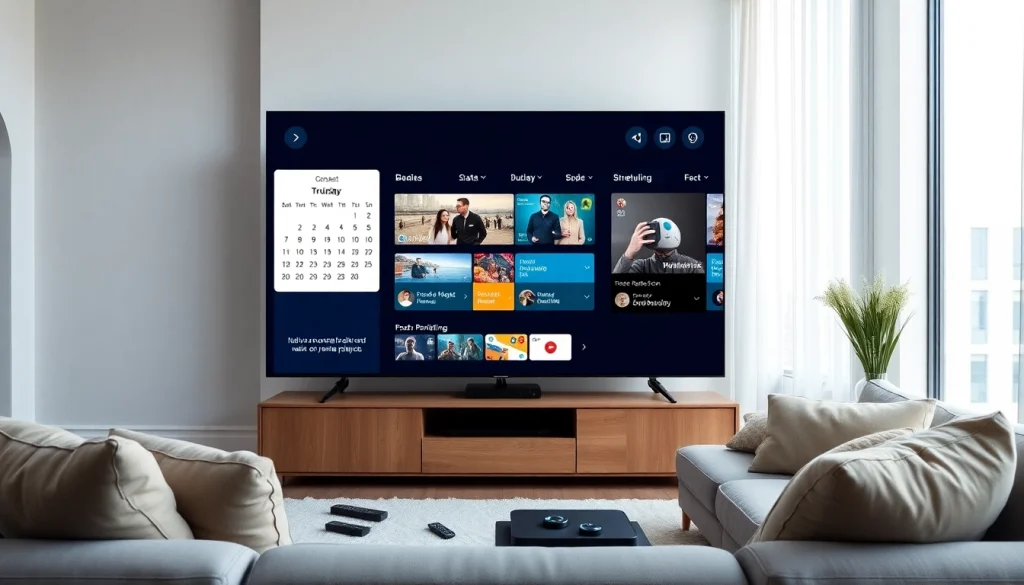Understanding Smart TV Scheduling Features
Overview of Smart TV Capabilities
Smart TVs have revolutionized the way we consume content, blending traditional television viewing with advanced technology. These devices connect to the internet and allow users to access a plethora of streaming services, social media platforms, and apps, all from the comfort of their living room. One of the standout features of smart TVs is their content scheduling capabilities. This allows users to automate viewing schedules, ensuring that specific content is played at designated times without manual intervention.
How Scheduling Works on Different Platforms
Scheduling content on smart TVs varies between different operating systems and brand frameworks. Most smart TVs provide an intuitive user interface for managing schedules through their settings menus. The core functionality generally involves setting start and end dates, repeating schedules, and integrating with calendars or content libraries. Some platforms offer deeper integration with other smart home devices, allowing users to synchronize TV operations with other household activities, such as home lighting or smart speakers.
Benefits of Scheduling Content on Smart TV
Using the Schedule content on smart TV feature offers various advantages. These include:
- Convenience: Automating your viewing schedule means less manual operation, allowing for a more seamless experience.
- Time Management: Users can effectively manage their viewing time, ensuring they don’t miss important events, shows, or presentations.
- Increased Engagement: For businesses using digital signage, scheduled content can dynamically engage customers and provide timely information.
- Energy Saving: Users can program their TVs to turn off during specified hours, contributing to energy conservation.
Step-by-Step Guide to Schedule Content on Smart TV
Accessing Scheduling Settings
The first step in scheduling content is accessing the scheduling settings on your smart TV. This process typically includes a few straightforward actions:
- Turn on your smart TV and access the main menu using your remote control.
- Navigate to the “Settings” section, which is usually marked by a gear icon.
- Look for “System” or “General” settings and select “Scheduling” or “Timer.” The wording might vary by manufacturer.
Creating Your Content Schedule
Once you’ve accessed the scheduling interface, creating your content schedule is the next crucial step. Here’s how to do it effectively:
- Select “Add New Schedule” or a similar option.
- Choose the type of content to be scheduled, such as a specific show, a movie, or a digital signage project.
- Specify start and end times, and if applicable, set the recurrence for daily, weekly, or monthly views.
- Review and confirm your settings before saving the schedule to ensure everything is set up correctly.
Testing Your Schedule for Effectiveness
After your schedule is set, it’s essential to test it to ensure everything works as intended. This may involve:
- Waiting for the scheduled time to see if the content plays as per the set schedule.
- Adjusting setting any discrepancies observed during the test.
- Checking whether the TV performs as expected with other integrated devices.
Common Challenges When Scheduling Content
Technical Issues and Troubleshooting
Despite the convenience of scheduling content, users may encounter several technical issues. Common challenges include connection problems, software glitches, and firmware updates failure, which can interrupt scheduled programming. If you are experiencing these issues, consider the following troubleshooting tips:
- Restart the smart TV to refresh its settings.
- Ensure that your TV’s firmware is up to date, as manufacturers frequently release updates with bug fixes and enhancements.
- Check your internet connection, as a weak or unstable connection can impact content loading.
User Interface Limitations
While most smart TVs provide the ability to schedule content, the user interface may not always be user-friendly. New users may find it challenging to navigate through menus or may not fully understand how to set schedules effectively. To mitigate this, consider using online guides or tutorials specific to your smart TV model. Many manufacturers also offer customer support to help users through the scheduling process.
Content Compatibility Problems
Instances occur where certain content types or formats are incompatible with user schedules. Users should be aware of the content types supported by their smart TVs. For instance, not all TVs support every streaming app, and specific file formats may not play correctly. Users should check compatibility indicators within their smart TV settings or consult user manuals for guidance on content types supported by their device.
Best Practices for Content Scheduling
Leveraging Analytics for Scheduling
Integrating analytics into your content scheduling strategy can significantly enhance viewer engagement. By analyzing viewer preferences and accessing viewership statistics, users can tailor their schedules to maximize impact. Here are some tips:
- Utilize built-in analytics features that track which content gets the most viewing time.
- Observe patterns in viewer behavior, such as preferred viewing hours and popular content types, to adjust schedules accordingly.
- Experiment with different scheduling times to see which ones yield the highest engagement rates.
Maintaining Audience Engagement
To keep viewers interested, it is essential to avoid repetitiveness in scheduled content. Varying the content types, such as mixing promotional videos with customer testimonials, can help maintain audience focus. Consider the following strategies:
- Incorporate seasonal and timely content relevant to your viewers’ current interests.
- Rotate shows or series in your schedule periodically to refresh viewer experience.
- Engage with your audience through surveys or feedback mechanisms to learn about their preferences and tailor your content scheduling accordingly.
Updates and Flexibility in Scheduling
Being flexible with your content scheduling is vital due to changing events or viewer preferences. Regularly review and update your content calendar, ensuring it’s relevant and timely. By allowing for spontaneous content changes, users can optimize their viewer engagement. Below are some strategies:
- Set reminders to review scheduled content to adapt any changes in programming as necessary.
- Stay informed about trending topics or events that may warrant last-minute scheduling adjustments.
- Implement a dynamic scheduling feature, if available, that automatically adjusts to current trends or viewer behavior.
Future Trends in Smart TV Scheduling
AI Integration and Automation
The future of smart TV scheduling lies in artificial intelligence and automation capabilities. These technologies will enable users to streamline scheduling processes by automatically curating content based on viewer preferences and consumption habits. Future innovations may include:
- AI-driven predictive analytics that forecast viewer trends and suggest optimal scheduling times automatically.
- Automated content curation, where systems learn user preferences over time to provide customized content schedules.
- Voice-activated scheduling via smart assistants, allowing users to schedule content using simple voice commands.
Enhanced User Experience Focus
As technology progresses, the user experience will see significant enhancements in smart TVs. This will include more intuitive interfaces and user-friendly scheduling functionalities. Future developments may feature:
- More seamless integration with smart home ecosystems, allowing for unified content experiences across devices.
- Enhanced visualization tools to manage content schedules effectively, reducing the complexity of navigating intricate scheduling options.
- Personalization features that tailor the viewing experience based on individual user profiles.
Impact of 5G on Smart TV Scheduling
The onset of 5G technology stands to revolutionize how smart TVs handle content scheduling and streaming. With faster speeds and better connectivity, users will experience a multitude of benefits:
- Reduced buffering times leading to smooth playback, even during scheduled content transitions.
- More robust support for high-definition and 4K content without connection worries.
- The ability to stream multiple content types seamlessly, including virtual reality and interactive programming that may rely on real-time adjustments to schedules.





